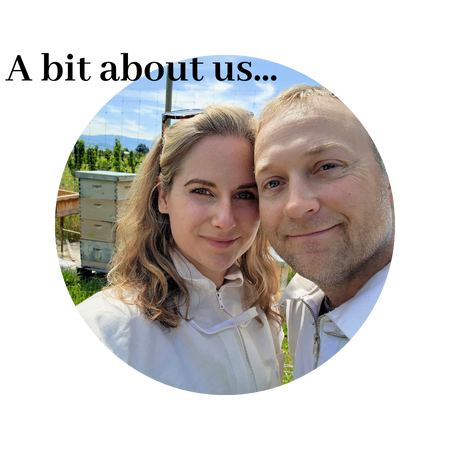In a honey bee colony, there are several different classification of honey bee and these are related to their physical makeup, as well as the jobs of the bees. These different classifications within a hive are called "castes".
Honey Bee Classifications
Honey bee castes include the Queen bee, the drone bees and the worker bees. Each caste has a very special and specific job, and we are going to explore the job description of the drone bee.
Honey bee drones are the mysterious male honey bees of the hive. Drones are the ONLY MALE honey bees.
There are very few drones that exist in any given bee hive. In a colony of say 15,000 honey bees, there may be only be 30 drones, and there is a reason why.
We are going to tell you all about the life of the honey be drone, what their important job is in the colony, and why there are so few drones in a bee hive.

Honey Bee Drones
Drone bees can come and go from the hive as they please and they have zero participation in hive maintenance or foraging and they obviously don't lay eggs as they are the only males of the colony.
Everything seems great, that is, until the worker bees decide they don't need them anymore.
We are going to cover a number of topics in this article about drone bees and they include:
- What a honey bee drone is
- What the job of a drone is
- How to identify a honey bee drone
What is a Drone Bee?
In a hive, there are three castes: there are worker bees, you have the Queen bee and the drone bee.
What is a honey bee drone?
A honey bee drone is the male offspring of the Queen bee. They have one very important function, and that is to mate with a Queen from another hive. Once they have achieved that goal they instantly (and explosively) die.
Once a drone delivers his genes into the Queen, she is fertile for her life, and what is even more interesting, is that a honey bee Queen can choose to fertilize an egg or not.
The way a Queen decides whether or not to fertilize an egg is based on the diameter of the wax cell she is laying into. And the Queen decides whether to create new drone bees or not.
Drone Cells
You see, when drone brood (or new drone bees) are needed, worker bees build drone cells that are about 17% larger than normal (5.2mm is the size for a regular worker bee cell whereas 6.2mm is the size for a drone cell).
When the Queen bee approaches the drone cell to lay her egg into, she measures the cell with her forelegs. If the cell is large, she will not fertilize the egg and it will become a drone bee.
Drone Bee Size
Drones are larger than worker bees so they need larger cell diameters. When the Queen sees these larger cells, she knows that more drones are needed and lays accordingly.
Once the drone eggs are laid into the larger drone cells and are capped by the worker bees, they can also be identified as drone cells as they are capped with a bulge; an almost bullet-shaped capping. They are now known as capped drone brood.
Seeing these developing drone bees (drone brood) in their cells are very obvious when viewing the hive frame.
Here is an example of a larvae in one of our backyard frames. This was probably a Queen developing.

What is the Job of a Drone Bee?
Drone bees perform no other tasks in the hive other than to mate with a Queen bee. If the drone is successful in mating with a Queen, he will instantly die.
Keep in mind, that the drone will not mate with the Queen of his own hive as he is her own offspring. He will mate with the Queen from another hive with whom he will encounter on her one mating flight.
Furthermore, since breeding is the only function of the drone bees, they are evicted from the hive before winter as mating only happens in the spring and summer months.
To keep the drones alive through the winter, they would only consume that valuable honey which is needed to keep the hive alive. So bye bye drones!
When it is time to evict a drone bee, the worker bees will attack the drones, chew off their wings and leave them for dead at the front of the hive. Cruel, but as with all things related to the honey bee, the colony comes first.
How to Identify a Honey Bee Drone
The most distinguishing feature of a honey bee drone is that they are about 30% larger than worker bees (but not quite as large as the Queen, keep in mind). That, along with their very large eyes on top of their heads make drones stand out fairly obviously.
Drones do not defend the hive like worker bees, so they have no stingers.
Drones are also very loud when they fly. As a young boy, I recall my father bringing the occasional drone to the house and watching as they crawled on my arm. I do the same with my kids now as a fun way to talk about bees with them.
There is no fear of them being stung as drones have no stingers, and this does not harm the drone in any way. Just be sure you can properly identify a drone yourself before attempting to touch one.
Here is a photo of a drone who was injured outside one of our hives in the backyard. Notice his huge eyes? Also, we love finding drones because they have no stingers. We can let them walk around on our hands and get to know them, and it doesn't harm them or us.
Holding a drone bee is a very exciting experience for kids and is quite educational!
Drones in summary
To summarize everything about a drone bee;
- Drone bees come from the Queen bee's unfertilized egg
- Drone larvae are raised in larger cells with bullet-shaped caps
- Drone bees are the only male bees in the hive
- Drone bees are about 30% larger than worker bees, but are not quite as large as the Queen bees
- Drone bees have very large eyes on the tops of their head
- Drone bees have no stinger
- The only job of a drone is to mate with the Queen bee of another hive, which upon doing, he instantly dies
- Drone bees are only alive for mating seasons. Worker bees get rid of any drone bees before winter
Drone and Honey Bee FAQ
1. What are the different types of bees in a hive, and what do they do?
A honey bee hive has three types of bees: queens, workers, and drones. The queen’s job is pretty straightforward—she lays all the eggs, sometimes up to 2,000 a day during peak season!
Worker bees are all female and do everything from cleaning the hive and feeding larvae to guarding the entrance and foraging for nectar and pollen. Drones, which are male bees, have one main job: mating with a queen from another hive. After that, their work is done, quite literally.
2. Why do drone bees get kicked out of the hive?
Drones are evicted in the late summer or fall because they don’t contribute to the hive’s winter survival. They don’t forage, defend the hive, or help raise young. When resources like honey become precious in colder months, worker bees give drones the boot to conserve energy and food. It sounds harsh, but it’s all about survival for the colony.
3. How does the queen bee become the queen?
A queen starts as a regular larva, just like any other bee, but she’s fed a diet of royal jelly throughout her development. This superfood triggers changes that allow her to become fertile and develop into a queen. When the current queen ages or the hive swarms, new queens are raised, and they’ll battle it out until one remains. It's like a royal drama, bee edition!
4. What happens if a hive loses its queen?
If a hive loses its queen, the colony goes into emergency mode. Worker bees will select a few young larvae and start feeding them royal jelly to raise a new queen. If this fails, the hive becomes hopelessly queenless, and the colony will eventually collapse without her to lay eggs and keep things running smoothly.
5. How do bees decide when to swarm?
Swarming happens when the hive gets crowded. The queen will lay eggs in special swarm cells, and the colony raises new queens. Meanwhile, the old queen and about half the workers prepare to leave and find a new home. It's how honey bees reproduce on a colony level. Think of it as nature's way of making sure they don’t put all their eggs in one basket (or hive, in this case).
Here are some other articles you may be interested in reading:
Everything Needed To Start BEEKEEPING
Where To Buy Beeswax Directly From Reputable Beekeepers
How To Make Beeswax Wraps | INSTRUCTIONS
Did you like this article?
❤️ Here's how you can support our blog:
My name is Linnea and I am a backyard gardening enthusiast! Along with my husband and our two kids (and chickens, ducks and our little dog Izzy). Our hobby - growing our own food and making our meals from scratch. My blog, The Farmers Cupboard, is the website that blossomed from that passion. I love every second I spend sharing our hobby with like minded backyard growers.
It's easy to support my blog, and it is so appreciated. Please SHARE an article somewhere, pin a photo to your Pinterest board, follow on any of our social medias or sign up for our newsletter! That's it!
These little things help our blog grow and allow us to continue doing what we love: growing good food and sharing what we learn.
PINTEREST PASSIONATE? We're opening up our cupboard to you!
Click on the pin below made just for you. It will bring you right to my little Pinterest community, where I would love for you to FOLLOW The Farmers Cupboard and see all of our gardening and backyard dream ideas!
Let's grow good things together!












0 comments